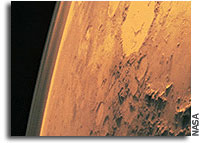Fate of Carbon and the Atmospheric Evolution of Mars

The climate of Mars likely evolved from a warmer, wetter early state to the cold, arid current state.
However, no solutions for this evolution have previously been found to satisfy the observed geological features and isotopic measurements of the atmosphere. Here we show that a family of solutions exist, invoking no missing reservoirs or loss processes. Escape of carbon via CO photodissociation and sputtering enriches heavy carbon (13C) in the Martian atmosphere, partially compensated by moderate carbonate precipitation. The current atmospheric 13C/12C and rock and soil carbonate measurements indicate an early atmosphere with a surface pressure <1 bar. Only scenarios with large amounts of carbonate formation in open lakes permit higher values up to 1.8 bar. The evolutionary scenarios are fully testable with data from the MAVEN mission and further studies of the isotopic composition of carbonate in the Martian rock record through time.
Renyu Hu, David M. Kass, Bethany L. Ehlmann, Yuk L. Yung
(Submitted on 2 Dec 2015)
Comments: Published 24 November 2015 on Nature Communications
Subjects: Earth and Planetary Astrophysics (astro-ph.EP); Space Physics (physics.space-ph)
Journal reference: Nature Communications 6, 10003 (2015)
DOI: 10.1038/ncomms10003
Cite as: arXiv:1512.00758 [astro-ph.EP] (or arXiv:1512.00758v1 [astro-ph.EP] for this version)
Submission history
From: Renyu Hu
[v1] Wed, 2 Dec 2015 16:25:51 GMT (793kb)
http://arxiv.org/abs/1512.00758








